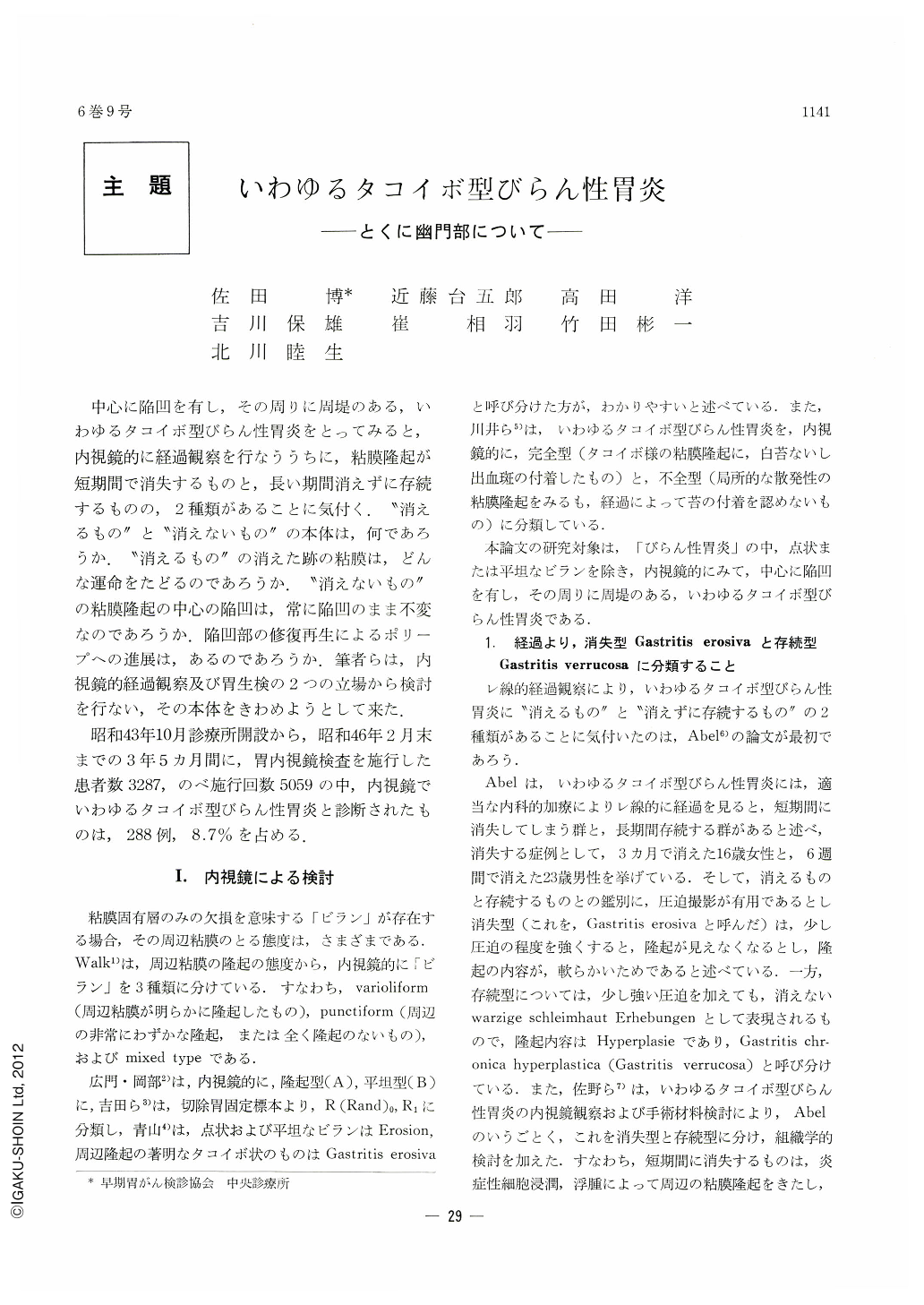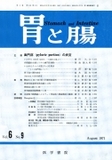Japanese
English
- 有料閲覧
- Abstract 文献概要
- 1ページ目 Look Inside
- サイト内被引用 Cited by
中心に陥凹を有し,その周りに周堤のある,いわゆるタコイボ型びらん性胃炎をとってみると,内視鏡的に経過観察を行なううちに,粘膜隆起が短期間で消失するものと,長い期間消えずに存続するものの,2種類があることに気付く.“消えるもの”と“消えないもの”の本体は,何であろうか.“消えるもの”の消えた跡の粘膜は,どんな運命をたどるのであろうか.“消えないもの”の粘膜隆起の中心の陥凹は,常に陥凹のまま不変なのであろうか.陥凹部の修復再生によるポリープへの進展は,あるのであろうか.筆者らは,内視鏡的経過観察及び胃生検の2つの立場から検討を行ない,その本体をきわめようとして来た.
昭和43年10月診療所開設から,昭和46年2月末までの3年5カ月間に,胃内視鏡検査を施行した患者数3287,のべ施行回数5059の中,内視鏡でいわゆるタコイボ型びらん性胃炎と診断されたものは,288例,8.7%を占める.
Endoscopic follow-up studies of varioliform erosions of the stomach, characterized by swollen, raised margins with central depressions, show that they can be classified into two varieties: the transient type (gastritis erosiva) and persistent type (gastritis verrucosa).
1. Mucosal changes in the transient type mostly disappear from one to three months since its onset, while those in the persistent type remain for as long as thirty two months at the longest.
2. Endoscopic characteristics.
(a) transient type: The slope of the raised margins is not so sharp, their height lower, with the central depression wider as compared with its bulging borders.
(b) persistent type: The sharply raised margins, sometimes constricted, are higher, with central depressions clearly circumscribed against the raised margins.
3. Seasonal incidence.
The onset of changes in the transient type is most frequent in April and October, while that in the persistent type is seen all through the year with a peak in September.
4. Age distribution.
The former is most often seen in the third decade and the latter in the fifth.
5. Age and localization of changes.
With the advancement of age, changes in both types take place more and more in the oral part of the stomach, from the antrum up to the corpus, showing a similar, interesting pattern to that of chronic gastritis.
6. Endoscopically, the persistent type can be divided into four varieties: type (a) (varioliform), type (b) (polypoid), type (c) (meandering) and type (d) (sausage-like). Types (c) and (d), though only a few in number, must be differertiated from similar-looking early gastric cancers, Ⅱa+Ⅱc or Ⅰ.
7. Bioptic findings.
(a) Gastritis verrucosa in the pyloric gland region shows that pyloric gland hyperplasia is predominant, and indifferent cell metaplasia is found at the bases of erosions.
(b) Gastritis verrucosa in the body gland region shows predominant foveolar hyperplasia, and sometimes foveolar irregular elongation and cystic formation is found.
(C) Transient type (gastritis erosiva) is characterized by inflammatory cellular infiltration with some foveolar hyperplasia.

Copyright © 1971, Igaku-Shoin Ltd. All rights reserved.


